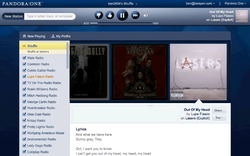the music genome project

Conceived by Tim Westergren, the Music Genome Project attempts an analytical approach to
organizing music genres as genomes, like a strand of DNA. The article Pandora and the
Music Genome Project details the history of the computer program. This project was launched in January of 2000 with an attempt to analyze the structure of a song so that the system could identify similar songs that a searcher might like. Originally a project of his company Savage Beast, it took five years and 30 experts in music theory to build their database because each
of the songs had to be individually listened to and up to 400 musical attributes manually assessed, which required 20 to 30 minutes for each four minutes of song. As of May 2006, the library contained in excess of 400,000 analyzed songs from 20,000+ contemporary artists. The database is almost double that size in 2013.
organizing music genres as genomes, like a strand of DNA. The article Pandora and the
Music Genome Project details the history of the computer program. This project was launched in January of 2000 with an attempt to analyze the structure of a song so that the system could identify similar songs that a searcher might like. Originally a project of his company Savage Beast, it took five years and 30 experts in music theory to build their database because each
of the songs had to be individually listened to and up to 400 musical attributes manually assessed, which required 20 to 30 minutes for each four minutes of song. As of May 2006, the library contained in excess of 400,000 analyzed songs from 20,000+ contemporary artists. The database is almost double that size in 2013.

Westergren describes Pandora in an interview with Music Business Insider in the following way: “It's an enormous musical taxonomy. Hundreds of thousands of songs have been analyzed by a trained musician for close to 400 musical attributes per song. So it's kind of like musical DNA, and that powers the way Pandora creates its radio stations. When you're a listener, what you do on Pandora is type in the name of an artist or a song that you like, and the Music Genome Project will look [in its database] at that song's sort of musical DNA,
and then go look for musical neighbors and start sequencing songs.”
and then go look for musical neighbors and start sequencing songs.”
The elements as "genes" that compose a sort of musical DNA for each song. Certain parts of each DNA string can link to
other songs with similar qualities. Tim Westergren identified several broad "Genomes" that Pandora uses to identify genres including Rock, Classical, Blues, and Holiday, with subcategories of British Invasion, and Choral (Baroque Period). In Pandora Maps the Musical Genome Westergren is interviewed and explains who the genomes are not the same as recognizes genres like folk or country, but instead analyze the things that might make music considered part of a genre. He discusses rhythm as an attribute: “The rhythm has a whole set of attributes that describe it, the use of syncopation, the meter, the rhythm, the level of swing, all the different elements. The idea, in a way, is that you could literally just look at the page where these scores are and hear the song in your head.” When you look over the list of more than 400 "genetic" attributes of music used by the project, you will identify connections beyond the basic mechanics of harmony, rhythm, and melody. Genomes include attributes like major
and minor key tonalities, vocal counterpoint, and dissonance, angry lyrics, acoustic guitar layering, busy electronic hat, mid-tempo shuffle feel, thin female vocal performance, and vocal scatting.
How does Pandora work on the user end? Via a browser or app for a smartphone, users create a radio station based on the
name of a band, song or musical style. Pandora then streams similar music, based on the genomes assigned similar music and depending on whether you give a thumbs up or down to the new suggestions; check thumbs up, and the program will
look for more songs with the characteristics of the one playing. Check thumbs down and get less songs like the one playing. The larger menu has additional information. It has a link that reads, "Why did you play this song?" It takes
you to the genetic elements of the song and why Pandora thinks it belongs on your station.
According to Rolling Stone Magazine in 2011, Pandora’s iPhone app is the second biggest free app of all time, behind
Facebook. The service has 80 million users, up almost 70 percent from 2009, with more than 30 million checking in each month. In 2009, the privately held company had its first profitable quarter, raking in $50 million in revenue for the year.
The rolling Stone implied that Pandora would change the underlying economics of the music business because what you hear on Pandora is not based on mass popularity or the muscle of record-label marketing and distribution. Instead, it
is contingent on what Pandora's software thinks you will enjoy.
Westergren has said about the genesis of the project: "Together we set out to capture the essence of music at the most fundamental level. We ended up assembling literally hundreds of musical attributes or 'genes' into a very large Music Genome. Taken
together these genes capture the unique and magical musical identity of a song-everything from melody, harmony, and rhythm to instrumentation, orchestration, arrangement, lyrics, and, of course, the rich world of singing and vocal harmony. It's not about what a band looks like or what genre they supposedly belong to, or about who buys their records-it's about what each
individual song sounds like."
other songs with similar qualities. Tim Westergren identified several broad "Genomes" that Pandora uses to identify genres including Rock, Classical, Blues, and Holiday, with subcategories of British Invasion, and Choral (Baroque Period). In Pandora Maps the Musical Genome Westergren is interviewed and explains who the genomes are not the same as recognizes genres like folk or country, but instead analyze the things that might make music considered part of a genre. He discusses rhythm as an attribute: “The rhythm has a whole set of attributes that describe it, the use of syncopation, the meter, the rhythm, the level of swing, all the different elements. The idea, in a way, is that you could literally just look at the page where these scores are and hear the song in your head.” When you look over the list of more than 400 "genetic" attributes of music used by the project, you will identify connections beyond the basic mechanics of harmony, rhythm, and melody. Genomes include attributes like major
and minor key tonalities, vocal counterpoint, and dissonance, angry lyrics, acoustic guitar layering, busy electronic hat, mid-tempo shuffle feel, thin female vocal performance, and vocal scatting.
How does Pandora work on the user end? Via a browser or app for a smartphone, users create a radio station based on the
name of a band, song or musical style. Pandora then streams similar music, based on the genomes assigned similar music and depending on whether you give a thumbs up or down to the new suggestions; check thumbs up, and the program will
look for more songs with the characteristics of the one playing. Check thumbs down and get less songs like the one playing. The larger menu has additional information. It has a link that reads, "Why did you play this song?" It takes
you to the genetic elements of the song and why Pandora thinks it belongs on your station.
According to Rolling Stone Magazine in 2011, Pandora’s iPhone app is the second biggest free app of all time, behind
Facebook. The service has 80 million users, up almost 70 percent from 2009, with more than 30 million checking in each month. In 2009, the privately held company had its first profitable quarter, raking in $50 million in revenue for the year.
The rolling Stone implied that Pandora would change the underlying economics of the music business because what you hear on Pandora is not based on mass popularity or the muscle of record-label marketing and distribution. Instead, it
is contingent on what Pandora's software thinks you will enjoy.
Westergren has said about the genesis of the project: "Together we set out to capture the essence of music at the most fundamental level. We ended up assembling literally hundreds of musical attributes or 'genes' into a very large Music Genome. Taken
together these genes capture the unique and magical musical identity of a song-everything from melody, harmony, and rhythm to instrumentation, orchestration, arrangement, lyrics, and, of course, the rich world of singing and vocal harmony. It's not about what a band looks like or what genre they supposedly belong to, or about who buys their records-it's about what each
individual song sounds like."
